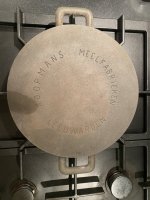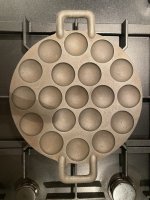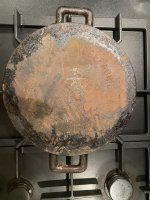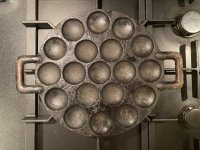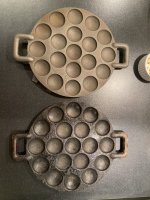Hopefully someone can help me a little on my first electrolysis restoration project...
I recently managed to get my hands on a couple of 80-90 year old 'poffertjespannen' (see attached photo's)
I've build an electrolysis tank and was extremely surprised by the result when I got the first one out of the tank.
It got stripped beautifully, and revealed some markings I didn't even know about.
However, before I managed to start seasoning it, I was confronted with flash rust, I think?
Since I'm very new to cooking with cast iron (and even more with restoration) I'm hoping someone will tell me where I went wrong...
The process I used was;
- Drop the old dirty pan in the tank
- As soon as it came out, rinse it with hot water and soap, then scrub it down as much as possible...
But by the time I was ready to start seasoning, it sort of looked rusty again.
Would this be normal behaviour, or maybe I did something wrong in the process?
Hence my questions for advice;
1. Did I make a mistake in the process? (I was trying to be as quick as possible, after getting it out of the tank)
2. What do I do to prevent the flash rust?
3. Should it be put back in the tank to get rid of the flash rust, but what do I need to different to prevent it from happening again? (Or is it a matter of scrubbing down further?)
4. Or is it looking perfectly fine to start re-seasoning? (I'm a little bit lost on what it should look like, before I start seasoning...)
Really hope someone will help me guide through this process...
I'd love to cook some 'poffertjes' for my little girl in these pans.
Many thanks,
Mark
PS. Both pans looked similar, so I'm sure you can recognise the one that went into the tank vs the one that didn't
I recently managed to get my hands on a couple of 80-90 year old 'poffertjespannen' (see attached photo's)
I've build an electrolysis tank and was extremely surprised by the result when I got the first one out of the tank.
It got stripped beautifully, and revealed some markings I didn't even know about.
However, before I managed to start seasoning it, I was confronted with flash rust, I think?
Since I'm very new to cooking with cast iron (and even more with restoration) I'm hoping someone will tell me where I went wrong...
The process I used was;
- Drop the old dirty pan in the tank
- As soon as it came out, rinse it with hot water and soap, then scrub it down as much as possible...
But by the time I was ready to start seasoning, it sort of looked rusty again.
Would this be normal behaviour, or maybe I did something wrong in the process?
Hence my questions for advice;
1. Did I make a mistake in the process? (I was trying to be as quick as possible, after getting it out of the tank)
2. What do I do to prevent the flash rust?
3. Should it be put back in the tank to get rid of the flash rust, but what do I need to different to prevent it from happening again? (Or is it a matter of scrubbing down further?)
4. Or is it looking perfectly fine to start re-seasoning? (I'm a little bit lost on what it should look like, before I start seasoning...)
Really hope someone will help me guide through this process...
I'd love to cook some 'poffertjes' for my little girl in these pans.
Many thanks,
Mark
PS. Both pans looked similar, so I'm sure you can recognise the one that went into the tank vs the one that didn't

